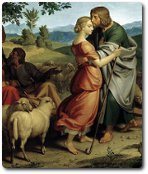The Handmaid's Tale Contents
Interpretation and the opening epigraphs
The reader's interpretation
The whole structure of The Handmaid's Tale challenges its readers. In the first chapter we are plunged into a strange situation where there has clearly been an extreme change in society, but we are not at all sure for some time what has happened. Atwood only reveals this gradually, just as she only gradually reveals information about Offred and her situation. However, when we reach the final section of the novel, we discover that we may have to re-think many of our assumptions.
Atwood never lets us forget that her work is a construct, and that our interpretation as readers makes us part of that construction. She also includes many puns and other examples of language-play, indicating that interpretation of meaning may not always be obvious.
The opening epigraphs
However, readers do have some clues about the direction in which Atwood's thoughts have taken her, and her attitudes to the events she is about to depict, from the three epigraphs she inserts before Chapter 1 - quotations which make her readers think carefully about what is to come as they start the novel.
An epigraph is a quotation or comment put at the start of a work in order to indicate the main ideas to be covered. The three epigraphs used by Margaret Atwood at the start of The Handmaid's Tale should certainly make readers think.
Epigraph 1
 The first quotation is from the first book of the Bible, Genesis, describing how the infertile Rachel told her husband Jacob to have intercourse with her handmaid. This is the biblical justification for the rulers in Atwood's fictional state, Gilead, to use the women they call ‘Handmaids' to bear children in a society where, for a variety of reasons, infertility and genetic deformities are prevalent.
The first quotation is from the first book of the Bible, Genesis, describing how the infertile Rachel told her husband Jacob to have intercourse with her handmaid. This is the biblical justification for the rulers in Atwood's fictional state, Gilead, to use the women they call ‘Handmaids' to bear children in a society where, for a variety of reasons, infertility and genetic deformities are prevalent.
Epigraph 2
The second quotation points the reader to Jonathan Swift's A Modest Proposal - a deeply ironic work (published in 1729) which attacks the cruelty and selfishness of the wealthy  English and their treatment of the starving Irish. Swift pretends to offer as a serious answer to food shortages the proposition that those Irish who cannot feed their children should eat them. His shocking satire makes his readers see their contemporary situation in a new light. The reference by Atwood to Swift's work is an indication to her readers that her purposes are also satirical and that she wants them to look with a new, more critical eye at late twentieth-century society.
English and their treatment of the starving Irish. Swift pretends to offer as a serious answer to food shortages the proposition that those Irish who cannot feed their children should eat them. His shocking satire makes his readers see their contemporary situation in a new light. The reference by Atwood to Swift's work is an indication to her readers that her purposes are also satirical and that she wants them to look with a new, more critical eye at late twentieth-century society.
Epigraph 3
The third quotation of a Sufi proverb – ‘In the desert there is no sign that says, Thou shalt not eat stones' - is more open to interpretation:
- A possible meaning is that in the desert there is nothing to eat except stones, but no-one wants to eat them, for they cannot sustain life. In other words, there is no point in prohibiting something that no-one wants to do anyway
- It could also mean - live with what you have, however terrible or life destroying it is.
In Gilead, so many things are prohibited, and people have little chance of doing what is prohibited - they live in ‘reduced circumstances' - but the human instinct for survival needs no direction. Rigorous tyrannies such as Gilead purport to know what is good for society, but human freedom is more important.
The Creation; Fall of humankind and universal or original sin; Noah and the Flood; the call of Abraham (start of salvation history), followed by the stories of the other patriarchs, Isaac, Jacob and Joseph.
Big ideas: Creation; Garden of Eden, Adam and Eve; Cain and Abel; Noah and the Flood; Patriarchs
Famous stories from the Bible: Adam and Eve / Creation; Noah's Ark; Abraham
Recently Viewed
Scan and go

Scan on your mobile for direct link.